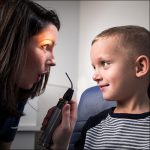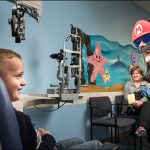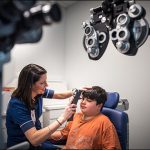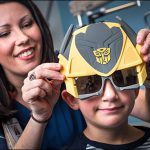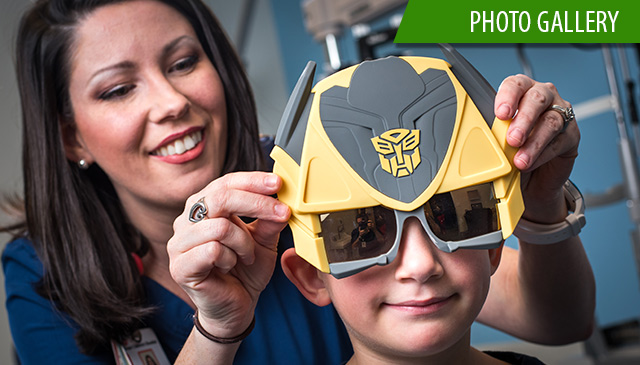 Candice Gardemal can calm the most nervous patient visiting Texas Children’s Specialty Care Cy-Fair for an eye exam. The certified ophthalmic technician wins over patients of all ages with her warm, bubbly personality and an endless amount of tricks up her sleeve, some of which are so effective they have been published in medical journals.
Candice Gardemal can calm the most nervous patient visiting Texas Children’s Specialty Care Cy-Fair for an eye exam. The certified ophthalmic technician wins over patients of all ages with her warm, bubbly personality and an endless amount of tricks up her sleeve, some of which are so effective they have been published in medical journals.
“She’s phenomenal,” said Dr. Mary Kelinske, an optometrist at the center who has been working with Gardemal for the past five years. “I couldn’t do my job as effectively without her.”
Gardemal’s role at the center is to get the vitals of a patient’s eye before Kelinske walks into the exam room. Most of the time, this includes patients reading various charts containing letters, numbers, and sometimes, pictures. And, almost always, it requires a patient’s eyes being dilated, a process adults, much less children, find unsettling.
Gardemal’s stealthy moves and methods of distraction, however, are magical, allowing her to get the job done quickly and usually with no fuss. From the moment she walks into the exam room, she is smiling, talking and pulling out toys from various drawers and cabinets around the room.
“Look right here,” she said energetically while pointing to a silver, shiny pinwheel that lights up in the dark. “There you go! You did it! You are so smart!”
For some of her tougher cases, Gardemal puts on a super hero mask just to get a laugh. Other times she points to one of the colorful, sea-themed murals she has painted on the exam room walls.
“Ms. Gardemal is an exceptional artist,” said Chief-of-Ophthalmology Dr. David Coats. “She combines her charisma and her art to enhance the appeal of our clinics and to put our children as ease. Her work includes small paintings and huge murals, some of which hide instruments that can be frightening to children.”
When dilating a patient’s eyes, Gardemal uses a technique she developed that involves a pile of tissue, the patient’s belly button and a tall tale that goes something like this:
“OK now, hold these tissues real tight over your belly button so that none of these eye drops can get inside,” Gardemal enthusiastically tells her patients. “If the drops get inside your belly button, hair will start sprouting up around it!”
This simple technique is so effective, Gardemal published an article about it in the Journal of American Association of Pediatric Ophthalmology. She got another article published in the same journal about a technique Gardemal came up with called the pinch patch. The technique uses a pinch in the fold of an eye patch to make what is typically a flat surface over a patient’s eye convex and therefore much more comfortable.
“Ms. Gardemal routinely dreams up and implements innovative ways to improve patient comfort,” Coats said. “One of the best innovations she has developed is the pinch patch. This is a simple modification to an eye patch that makes wearing an eye patch much more comfortable, which has been great news for our young patients who often must wear an eye patch several hours a day for many months or even years.”
Most recently, Gardemal has been working with Kelinske to provide a better clinical experience to patients with a range of physical, developmental and behavioral differences, including ADHD and Autism. Through exams geared toward the unique requirements of these patients, Gardemal and Kelinske have modified their approaches, as needed, to keep patients as comfortable as possible, both physically and emotionally, and to help get information and deliver care as accurately and efficiently as possible.
“My goal is to distract my patients with fun and leave them with a good memory of the eye doctor,” said Gardemal, who as a child had to visit the ophthalmologist frequently due to a condition called strabismus. “My childhood doctor always gave me a high five and a smile to make me feel more comfortable and it worked. I want to do the same for my patients. I want them to leave the clinic feeling like they had a good time.”
Click here to learn more about the Texas Children’s Special Needs Eye Clinic.





